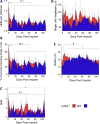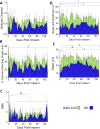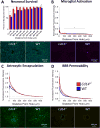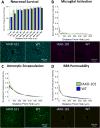Inhibition of the cluster of differentiation 14 innate immunity pathway with IAXO-101 improves chronic microelectrode performance
- PMID: 29219114
- PMCID: PMC5818286
- DOI: 10.1088/1741-2552/aaa03e
Inhibition of the cluster of differentiation 14 innate immunity pathway with IAXO-101 improves chronic microelectrode performance
Erratum in
-
Erratum.J Neural Eng. 2018 Jun 1;15(3):039601. doi: 10.1088/1741-2552/aab5bf. Epub 2018 Apr 16. J Neural Eng. 2018. PMID: 31186653 Free PMC article.
Abstract
Objective: Neuroinflammatory mechanisms are hypothesized to contribute to intracortical microelectrode failures. The cluster of differentiation 14 (CD14) molecule is an innate immunity receptor involved in the recognition of pathogens and tissue damage to promote inflammation. The goal of the study was to investigate the effect of CD14 inhibition on intracortical microelectrode recording performance and tissue integration.
Approach: Mice implanted with intracortical microelectrodes in the motor cortex underwent electrophysiological characterization for 16 weeks, followed by endpoint histology. Three conditions were examined: (1) wildtype control mice, (2) knockout mice lacking CD14, and (3) wildtype control mice administered a small molecule inhibitor to CD14 called IAXO-101.
Main results: The CD14 knockout mice exhibited acute but not chronic improvements in intracortical microelectrode performance without significant differences in endpoint histology. Mice receiving IAXO-101 exhibited significant improvements in recording performance over the entire 16 week duration without significant differences in endpoint histology.
Significance: Full removal of CD14 is beneficial at acute time ranges, but limited CD14 signaling is beneficial at chronic time ranges. Innate immunity receptor inhibition strategies have the potential to improve long-term intracortical microelectrode performance.
Conflict of interest statement
The authors have no conflict of interest related to this work to disclose.
Figures




Similar articles
-
Understanding the Role of Innate Immunity in the Response to Intracortical Microelectrodes.Crit Rev Biomed Eng. 2018;46(4):341-367. doi: 10.1615/CritRevBiomedEng.2018027166. Crit Rev Biomed Eng. 2018. PMID: 30806249 Free PMC article. Review.
-
Targeting CD14 on blood derived cells improves intracortical microelectrode performance.Biomaterials. 2018 May;163:163-173. doi: 10.1016/j.biomaterials.2018.02.014. Epub 2018 Feb 13. Biomaterials. 2018. PMID: 29471127 Free PMC article.
-
The Role of Toll-Like Receptor 2 and 4 Innate Immunity Pathways in Intracortical Microelectrode-Induced Neuroinflammation.Front Bioeng Biotechnol. 2018 Aug 14;6:113. doi: 10.3389/fbioe.2018.00113. eCollection 2018. Front Bioeng Biotechnol. 2018. PMID: 30159311 Free PMC article.
-
Neuroinflammatory Gene Expression Analysis Reveals Pathways of Interest as Potential Targets to Improve the Recording Performance of Intracortical Microelectrodes.Cells. 2022 Jul 30;11(15):2348. doi: 10.3390/cells11152348. Cells. 2022. PMID: 35954192 Free PMC article.
-
Intracortical recording interfaces: current challenges to chronic recording function.ACS Chem Neurosci. 2015 Jan 21;6(1):68-83. doi: 10.1021/cn5002864. Epub 2015 Jan 14. ACS Chem Neurosci. 2015. PMID: 25587704 Review.
Cited by
-
Understanding the Role of Innate Immunity in the Response to Intracortical Microelectrodes.Crit Rev Biomed Eng. 2018;46(4):341-367. doi: 10.1615/CritRevBiomedEng.2018027166. Crit Rev Biomed Eng. 2018. PMID: 30806249 Free PMC article. Review.
-
Inflammatory Foreign Body Response Induced by Neuro-Implants in Rat Cortices Depleted of Resident Microglia by a CSF1R Inhibitor and Its Implications.Front Neurosci. 2021 Mar 26;15:646914. doi: 10.3389/fnins.2021.646914. eCollection 2021. Front Neurosci. 2021. PMID: 33841088 Free PMC article.
-
In Vivo Characterization of Intracortical Probes with Focused Ion Beam-Etched Nanopatterned Topographies.Micromachines (Basel). 2024 Feb 17;15(2):286. doi: 10.3390/mi15020286. Micromachines (Basel). 2024. PMID: 38399014 Free PMC article.
-
A small-molecule TLR4 antagonist reduced neuroinflammation in female E4FAD mice.Alzheimers Res Ther. 2023 Oct 19;15(1):181. doi: 10.1186/s13195-023-01330-6. Alzheimers Res Ther. 2023. PMID: 37858252 Free PMC article.
-
Differential expression of genes involved in the chronic response to intracortical microelectrodes.Acta Biomater. 2023 Oct 1;169:348-362. doi: 10.1016/j.actbio.2023.07.038. Epub 2023 Jul 26. Acta Biomater. 2023. PMID: 37507031 Free PMC article.
References
-
- Hochberg LR, Serruya MD, Friehs GM, Mukand JA, Saleh M, Caplan AH, Branner A, Chen D, Penn RD, Donoghue JP. Neuronal ensemble control of prosthetic devices by a human with tetraplegia. Nature. 2006;442:164–71. - PubMed
-
- Ajiboye AB, Willett FR, Young DR, Memberg WD, Murphy BA, Miller JP, Walter BL, Sweet JA, Hoyen HA, Keith MW, Peckham PH, Simeral JD, Donoghue JP, Hochberg LR, Kirsch RF. Restoration of reaching and grasping movements through brain-controlled muscle stimulation in a person with tetraplegia: a proof-of-concept demonstration. The Lancet - PMC - PubMed
-
- Liu X, McCreery DB, Bullara LA, Agnew WF. Evaluation of the stability of intracortical microelectrode arrays. IEEE Trans Neural Syst Rehabil Eng. 2006;14:91–100. - PubMed
-
- Ward MP, Rajdev P, Ellison C, Irazoqui PP. Toward a comparison of microelectrodes for acute and chronic recordings. Brain Research. 2009;1282:183–200. - PubMed
Publication types
MeSH terms
Substances
Grants and funding
LinkOut - more resources
Full Text Sources
Other Literature Sources
Research Materials
